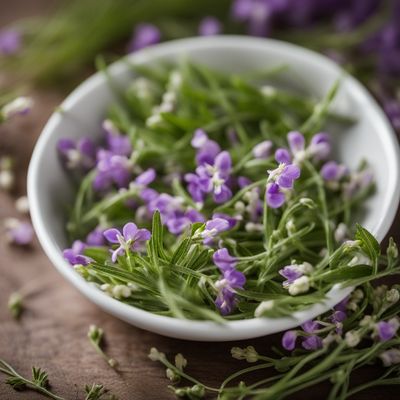
Ingredient
Clubmoss infusion leaves
The Ancient Elixir: Unveiling the Mysteries of Clubmoss Infusion Leaves
Clubmoss infusion leaves, also known as Lycopodium clavatum, are derived from a type of fern-like plant that grows in damp and shaded areas. These leaves have a delicate texture and a subtle earthy flavor with hints of pine and citrus. They are often used to infuse liquids, such as teas, broths, and cocktails, to impart their unique taste and potential health properties.
Origins and history
Clubmoss infusion leaves have a rich history dating back to ancient times. They were traditionally used by indigenous cultures for their medicinal properties, particularly in treating digestive issues, respiratory ailments, and skin conditions. In culinary practices, these leaves were used to add flavor and aroma to various dishes, especially in Scandinavian and Eastern European cuisines. Today, clubmoss infusion leaves continue to be valued for their potential health benefits and are incorporated into herbal remedies and culinary creations.
Nutritional information
Clubmoss infusion leaves are a good source of antioxidants, vitamins, and minerals. They are low in calories and fat, making them a healthy addition to various recipes. Additionally, these leaves are known for their potential anti-inflammatory and antimicrobial properties, which may contribute to overall well-being.
Allergens
Clubmoss infusion leaves are not known to be associated with any common allergens. However, individuals with specific plant allergies or sensitivities should exercise caution and consult with a healthcare professional before consuming products containing clubmoss infusion leaves.
How to select
When selecting clubmoss infusion leaves, look for dried leaves that are whole and intact. Avoid leaves that appear discolored, moldy, or have a strong musty odor, as these may indicate poor quality or contamination. It is advisable to purchase from reputable suppliers or specialty stores that specialize in herbal products to ensure freshness and authenticity.
Storage recommendations
To maintain the freshness and potency of clubmoss infusion leaves, store them in an airtight container in a cool, dry place away from direct sunlight. Avoid exposure to moisture or humidity, as it may cause the leaves to lose their flavor and become moldy. Proper storage will help preserve the quality and extend the shelf life of the leaves.
How to produce
Clubmoss infusion leaves can be challenging to produce at home due to the specific growing conditions required. They thrive in damp and shaded areas with high humidity, making them more suitable for commercial cultivation or wild harvesting. However, if you have access to suitable growing conditions, you can attempt to grow clubmoss plants from spores or propagate them from existing plants.
Preparation tips
Clubmoss infusion leaves can be used to infuse various liquids, such as water, broths, teas, or cocktails. To prepare an infusion, steep a handful of dried leaves in hot water or other desired liquids for about 10-15 minutes. Strain the liquid and discard the leaves before using or consuming. The infused liquid can be used as a base for soups, sauces, or beverages, adding a unique flavor twist to the final dish. It is important to note that clubmoss infusion leaves should be used in moderation due to their potent flavor.
Culinary uses
Clubmoss infusion leaves are commonly used in traditional medicine and herbal remedies. They are also utilized in Scandinavian and Eastern European cuisines to add flavor to soups, stews, and traditional beverages. Additionally, these leaves can be incorporated into modern mixology, where they are used to infuse cocktails with their distinct taste and aroma.
Availability
Clubmoss infusion leaves are native to Europe, North America, and parts of Asia. They can be found in regions with suitable growing conditions, such as damp forests, shaded areas, or near bodies of water. Commercial cultivation and wild harvesting are the primary methods of obtaining clubmoss infusion leaves.
More ingredients from this category » Browse all

Clary sage infusion leaves
The Aromatic Herb for Culinary and Medicinal Delights

Goat´s rue infusion leaves
"The Herbal Elixir: Unveiling the Wonders of Goat's Rue Infusion Leaves"

Smooth rupturewort infusion leaves
The Tranquil Herbal Elixir

Gymnema infusion leaves
The Sweet-Suppressing Herb

Lime infusion leaves
Zesty Citrus Elixir: Unveiling the Magic of Lime Infusion Leaves

Sweet orange infusion leaves
Citrus Delight

Eyebright infusion leaves
The Visionary Herb: Exploring the Benefits of Eyebright Infusion Leaves

Rock rose infusion leaves
The Fragrant Elixir: Exploring the World of Rock Rose Infusion Leaves

Toadflax infusion leaves
The Herbal Elixir of Toadflax

Golden root infusion leaves
Exploring the Golden Elixir: Unveiling the Power of Golden Root Infusion

Tea tree infusion leaves
"The Healing Elixir: Unveiling the Power of Tea Tree Infusion Leaves"

Alpine ladies mantle infusion leaves
The Enchanting Elixir: Unveiling the Magic of Alpine Ladies Mantle Infusion Leaves